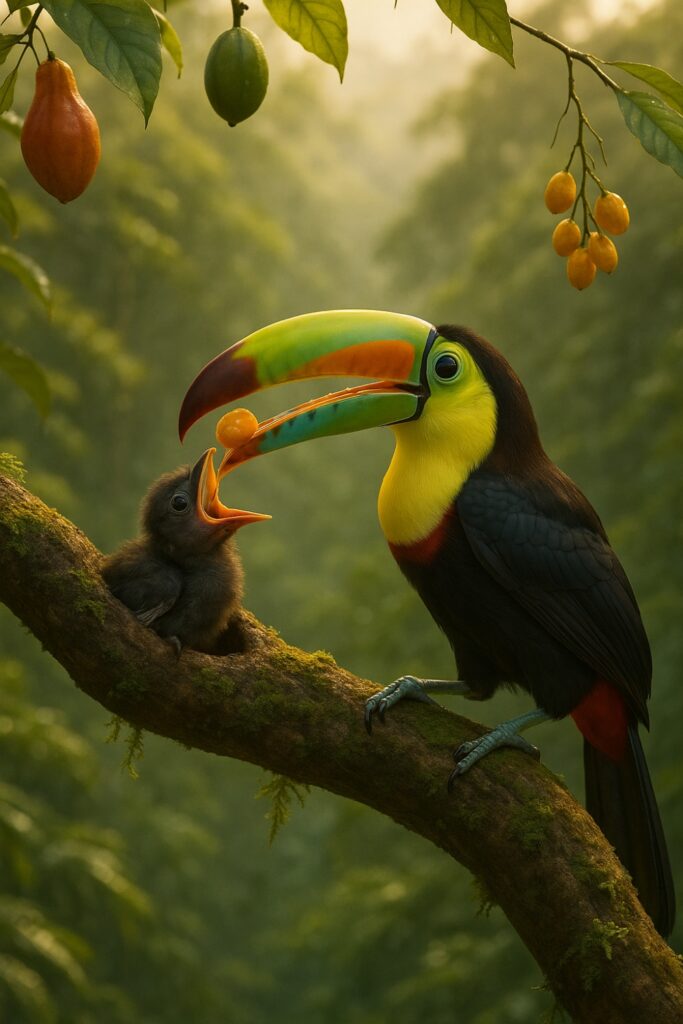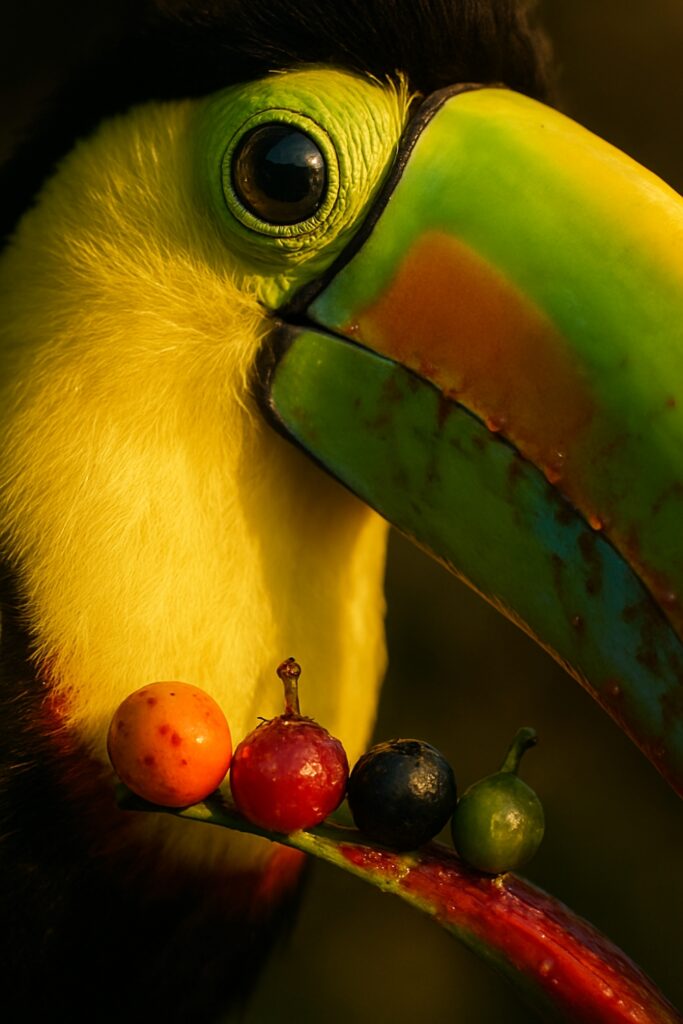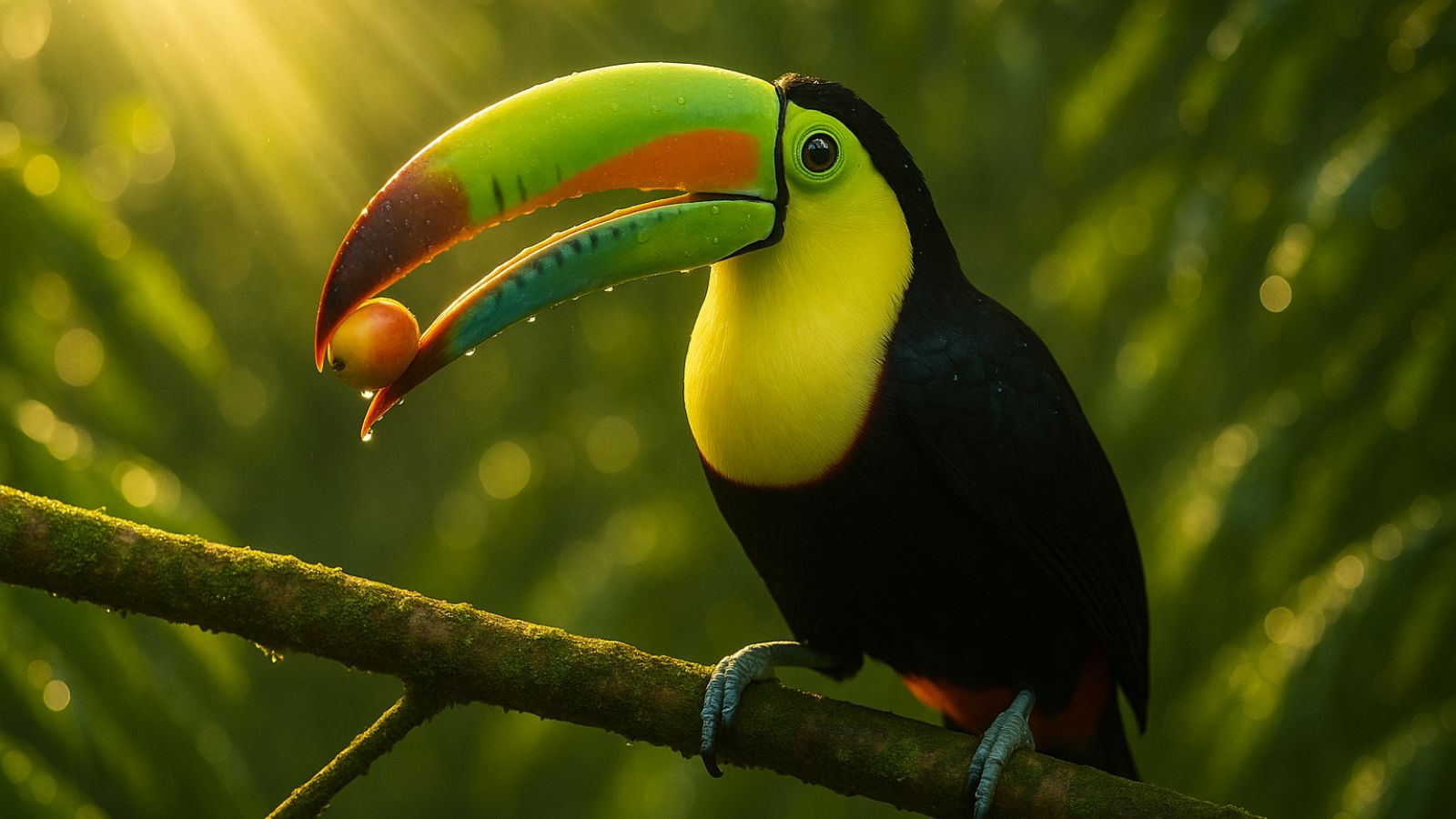Keel-billed toucans are primarily frugivorous birds, with fruit comprising 60-70% of their diet. These Central American rainforest birds consume a wide variety of tropical fruits, including papaya, mango, banana, berries, and native species like gumbo-limbo and foxtail palm.
Key Takeaways
- Fruit forms the foundation of the keel-billed toucan’s diet, comprising 60-70% of their daily food intake
- Omnivorous feeding behaviour includes insects, lizards, tree frogs, eggs, and occasionally small birds
- Specialised feeding technique involves grasping food with their bill, flipping it into the air, and catching it in their mouths
- Seed dispersal role makes them vital for rainforest regeneration as they regurgitate larger seeds, whilst smaller ones pass through their digestive system
- Seasonal availability influences their diet, with different fruits becoming available throughout the year.

Related Post: Baby Keel-Billed Toucan.
Primary Diet: Fruits and Berries
Fruit as the Foundation
Fruits constitute the overwhelming majority of the keel-billed toucan’s diet, making up approximately 60-70% of their daily food consumption. These birds are classified as frugivorous, meaning they are primarily fruit-eating creatures that have evolved specifically to process a wide variety of tropical fruits.
The toucan’s remarkably dexterous bill enables it to access fruits that other birds cannot reach. Despite appearing cumbersome, the bill is surprisingly lightweight due to its hollow construction made of keratin protein with thin bone supports.
Specific Fruit Varieties
Research has documented several specific fruit species that form part of the keel-billed toucan’s diet:
- Cymbopetalum mayanum (Annonaceae family)
- Gumbo-limbo (Bursera simaruba)
- Foxtail palm (Wodyetia bifurcata)
- Papaya, mango, and banana
- Berries, melon, apples, pears, and grapes.
Feeding Behaviour and Technique
The keel-billed toucan employs a distinctive feeding technique when consuming fruit. They grasp the fruit with their bill, flip it up into the air, and then catch it in their mouths before swallowing it whole. This acrobatic feeding behaviour allows them to efficiently process large quantities of fruit throughout the day.
When eating, toucans swallow fruit whole and subsequently regurgitate larger seeds, whilst smaller seeds pass through their digestive system. This behaviour is crucial for forest regeneration, as toucans serve as important seed dispersers for the tropical plants they consume.
Secondary Food Sources
Insects and Invertebrates
Insects form a significant secondary component of the keel-billed toucan’s diet, providing essential protein and nutrients. They consume various invertebrates, including:
- Beetles and other flying insects
- Caterpillars and larvae
- Ants and termites
- Spiders and other arachnids.
Small Vertebrates
Keel-billed toucans are opportunistic feeders that will consume small vertebrates when available:
- Lizards – frequently caught from tree branches and undergrowth
- Tree frogs – captured during their arboreal movements
- Small birds – occasionally predated upon
- Bird eggs and nestlings – taken from accessible nests
Unusual Dietary Items
Recent research has documented some unusual feeding behaviours in keel-billed toucans. In 2018, researchers in Costa Rica observed a keel-billed toucan eating carrion, making it possibly the first toucan species documented consuming dead animal matter.
Feeding Habits and Behaviour
Daily Feeding Patterns
Keel-billed toucans are crepuscular feeders, meaning they are most active during dawn and dusk. They typically feed in the forest canopy, moving from branch to branch by hopping rather than sustained flight due to their heavy wings.
Social Feeding
These birds are highly social and often feed in groups of six to twelve individuals. They maintain constant communication through loud croaking calls that can be heard up to half a mile away, particularly during feeding sessions.
Seasonal Variations
The toucan’s diet varies seasonally based on fruit availability throughout the year. During periods when preferred fruits are scarce, they increase their consumption of insects and other protein sources to maintain nutritional balance.

Ecological Importance
Seed Dispersal
Keel-billed toucans play a crucial role in rainforest ecology through their seed dispersal activities. Large seeds that are digested and regurgitated by toucans have a higher chance of sprouting than those that are not processed by the birds. This makes them essential for maintaining forest diversity and regeneration.
Forest Gardening
Their feeding behaviour effectively makes them forest gardeners, helping to plant new trees throughout their territory. Smaller seeds that pass through their digestive system are deposited in various locations, often in nutrient-rich droppings that provide excellent growing conditions.
Feeding Adaptations
Bill Functionality
The keel-billed toucan’s oversized bill is perfectly adapted for their feeding lifestyle. The bill allows them to:
- Reach high-hanging fruit that other birds cannot access
- Probe deep into nests and tree crevices for eggs and nestlings
- Dissect larger fruits into manageable pieces
- Regulate body temperature through a network of blood vessels.
Digestive System
Toucans have a relatively short digestive tract that processes food quickly. This means they must consume large volumes of food and have frequent, often loose droppings, sometimes occurring within 15-20 minutes after eating certain fruits like blueberries.
Captive Diet Considerations
Nutritional Requirements
In captivity, maintaining a proper diet for keel-billed toucans requires careful attention to iron content. These birds are susceptible to hemochromatosis (iron storage disease), so their diet must contain less than 90-100 parts per million of iron.
Recommended Captive Foods
Captive toucans should receive:
- 60-70% fresh fruits (avoiding citrus, which can increase iron absorption)
- 20-30% low-iron softbill pellets
- Small amounts of insects for protein.
Conservation Implications
Understanding the keel-billed toucan’s dietary requirements is crucial for conservation efforts. Habitat loss poses a significant threat to these birds, particularly the loss of fruit-bearing trees that form the foundation of their diet. Conservation programmes must focus on protecting diverse tropical forests that provide the variety of fruits these birds require throughout the year.
Conclusion
The keel-billed toucan’s diet represents a sophisticated adaptation to life in Central American rainforests. Their primarily frugivorous lifestyle, supplemented by opportunistic feeding on insects and small vertebrates, makes them both successful forest dwellers and crucial ecosystem engineers. Through their seed dispersal activities, these remarkable birds help maintain the very forests they depend upon for survival.
Understanding their dietary requirements provides valuable insights for both conservation efforts and captive care programmes. As deforestation continues to threaten their natural habitat, protecting the diverse array of fruit-bearing trees that sustain keel-billed toucans becomes increasingly important for their long-term survival.
FAQ: What Does the Keel-Billed Toucan Eat?
What percentage of a keel-billed toucan’s diet is fruit?
A: Fruit comprises 60-70% of a keel-billed toucan’s diet, making them primarily frugivorous birds.
Do keel-billed toucans eat meat?
A: Yes, they occasionally eat small vertebrates, including lizards, tree frogs, bird eggs, nestlings, and even small birds.
How do keel-billed toucans eat their food?
A: They grasp food with their bill, flip it up into the air, and catch it in their mouths before swallowing it whole.
What insects do keel-billed toucans eat?
A: They consume various insects, including beetles, caterpillars, ants, termites, and spiders.
Are keel-billed toucans important for seed dispersal?
A: Yes, they play a crucial role in rainforest regeneration by regurgitating larger seeds and passing smaller seeds through their digestive system.
What fruits do keel-billed toucans prefer?
A: They eat a wide variety, including papaya, mango, banana, berries, gumbo-limbo, and various native Central American fruits.
Do keel-billed toucans drink water?
A: Yes, they require fresh, clean water daily and often bathe in their water sources.
Can keel-billed toucans eat citrus fruits?
A: In captivity, citrus fruits should be avoided as they can increase iron absorption and contribute to iron storage disease.
How often do keel-billed toucans eat?
A: They are most active feeders during dawn and dusk, but eat frequently throughout the day due to their fast metabolism.
What role do keel-billed toucans play in the ecosystem?
A: They serve as important seed dispersers, helping to maintain forest diversity and regeneration through their feeding activities.
